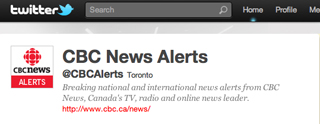Journalists today are expected to be active on social media, sharing observations, anecdotes and links with their audience. Facebook itself is reaching out to newsrooms, recently launching the Journalists on Facebook page as a resource for the media.
But a study from Canada suggests more people prefer to get their news via their friends and acquaintances on social media, than from a journalist or news organization. And there are mixed signals as to whether audiences think journalists should be using Twitter in their professional work.
I was the lead author of the study, “Social Networks Transforming How Canadians Get the News,” from the Canadian Media Research Consortium (CMRC). It gave further evidence of the impact social media is having on how people get the news and from whom. Social media services are turning into personalized news streams for Canadians of all ages, who rely on their digital circle of friends, family and acquaintances to alert them to interesting news and information.
The CMRC study is based on an online survey of a representative national sample of 1,682 adults conducted by Angus Reid Public Opinion. The margin of error — which measures sampling variability — is +/- 2.5%, 19 times out of 20.
Keeping up with the news was one of the attractions of social networks for more than two-thirds of social media users. Every day, almost half of social media users in Canada get some of their news every day via links and recommendations from friends, family and colleagues who broadened their horizons, the study found.
A study by Pew Research last year found a similar trend taking place in the U.S., as news consumers increasingly shared links and recommendations in their social networks.
Your friend as your news editor
People have always shared the news, from discussing last night’s news bulletin to sending a newspaper clipping. But social media is extending the ability of audiences to influence the distribution and reach of news.
The CMRC study points to the growing influence of users to decide what is seen and read, as newsrooms jump onto social media platforms as a new way to distribute content and reach a bigger audience.
The survey showed that Canadians were twice as likely to get news from friends on social networks than from journalists or official news accounts. Only one in five said they receive news from a media outlet on social networks. For Twitter, only one in ten get their news from tweeting journalists.

The figures signal that it is more important for a newsroom to get others to share and recommend content than to do it through an official account. The study suggests that the more than 18 million Canadians on Facebook and almost 5 million on Twitter are becoming the news editors for their social circles, deciding whether a story, video or other piece of content is interesting enough to recommend.
Should Journalists Tweet?
As journalists increasing use Twitter and tap into social media for reporting, networking and storytelling, the CMRC study strikes a note of caution. Canadians were evenly divided on whether news organizations should include information gleaned from social media into their reports.
There was a similar ambivalence when it came to whether journalists should even use Twitter to report the news. While 39 percent said yes, 34 percent said no and 26 percent were unsure. The ambiguous results suggest that Twitter may just be too new for audiences to decide whether it is a good or bad thing for the media.
Perhaps more significantly, younger Canadians were much more comfortable with a more social type of journalism, which is not surprising given how social media has become woven into the fabric of their lives.
The CMRC study found that a majority of under-34-year-olds in Canada use social media regularly, and that younger adults tended to be heavier users. Students, in particular, were much more comfortable with the idea of journalists integrating social media content into their reporting.
Similarly, just over half of students agreed that journalists should use Twitter to help report on trends and issues. The figures suggest a generational divide in attitudes toward social media and journalism.
For example, the study found that virtually no one over 55 follows journalists on Twitter. But kids who have grown up with the social web seem far more accepting of news organizations and journalists integrating these new services into their daily routines.
The conundrum for media organizations
Social media presents tremendous possibilities for journalists to reach audiences, expand their range of sources and engage with communities. The changing consumption patterns for news also raise questions for media organizations.
Sharing the news is becoming an important part of how people experience the news. The CMRC study found that 64 percent of news consumers value being able to easily share content, rising to 83 percent for those under the age of 34. But those “share” and “like” buttons tend to point users towards Facebook or Twitter, undermining existing mass media business models based on delivering large audiences to advertisers.
While social media creates new opportunities for the news industry to reach and engage audiences, particularly younger Canadians, it also represents competition for consumer attention and revenue. It further fragments the audience and potentially could signal a shift in reader loyalty from a news brand to their social circle.
Alfred Hermida is the lead author on the CMRC report on social media. He is an online news pioneer and digital media scholar. He is an assistant professor at the Graduate School of Journalism, the University of British Columbia, where he leads the integrated journalism program. He was a founding news editor of the BBC News website. He blogs at Reportr.net.

